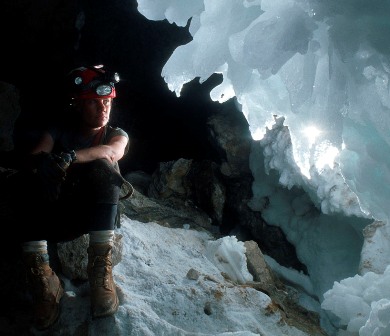|
You are viewing ARCHIVED content published online before January 20, 2025.
Please note that this content is NOT UPDATED, and links may not work. For current information,
visit https://www.nps.gov/aboutus/news/index.htm.

Max Wisshak, www.speleo-foto.de, used with persmission
Contact: Paula Bauer Microbes from National Park Cave Change Understanding of Antibiotic Resistance While visitors explore national parks for enjoyment and to learn about various natural and cultural resources, researchers in numerous fields come to national parks to gain an understanding of our history, our world and the life forms with which we share it. A scientific paper published today in PLoS ONE illustrates the value of national parks for cutting-edge research, in unique environments where world-changing discoveries are being made.
Carlsbad Caverns National Park granted permits to Hazel Barton and her colleagues to collect the microbes within the park for studies aimed at understanding how life can thrive in the nutrient poor world deep underground. From the human perspective, it is puzzling that life can survive where there is "nothing" to eat except rocks, air, water, and microbes, and where the sun's energy, which provides our food sources, has no affect. Yet, complex microbial communities seem to exist and thrive in the caves by consuming minerals in the environment and each other. For this type of research, Barton explained, "Lechuguilla Cave is absolutely unique", a perfect source for the uncontaminated, isolated microbes they need. In addition, Barton explained that the long term studies of the geology of the area's caves allowed them to state conclusively that these microbial communities have been isolated since before antibiotics were first used by doctors. Lechuguilla Cave, discovered in 1986, is well known for its size (over 135 miles of mapped passage ways), depth (1,604 feet), and mix of beautiful, massive and delicate cave formations. To protect the cave's natural features, including the microbial life, access into the cave is limited to about one hundred people per year, who enter for reasons of science and exploration. In order to reach the deep, remote sections of the cave system, Barton and her team must spend several days underground, crawling, climbing, and rappelling through miles of cave passages. Barton has been coming to Carlsbad Caverns National Park for research for over a decade. She plans to publish other research involving microbes collected in the park, such as a paper with Dr. Brian Bachmann at Vanderbilt University, describing the unique chemical agents, with antibiotic properties, made by these microbes. She said, "We're also looking at how the diversity of the organisms change as the cave gets deeper, so we can understand how microbes get energy in the absence of sunlight - life without light. And we're also looking at 'rock eating microbes' in the cave with Dr. Heather Bullen at Northern Kentucky University." Barton is one of several researchers studying resources in Carlsbad Caverns National Park. Other subjects of study and inventory include cave climate, moths, bees, surface springs, archeological sites, soil types, cave swallows, bats, and how the caves of the Guadalupe Mountains formed. Findings from studies like these not only help us all better understand these resources, but also help park managers care for them. For more information about park programs, natural and cultural resources, and educational opportunities, please visit the park's website: www.nps.gov/cave. |
Last updated: May 5, 2025
